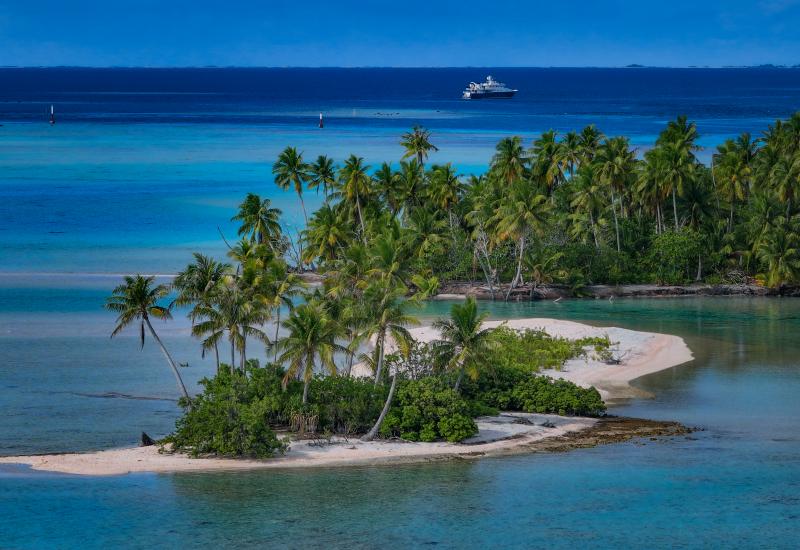Isla de la Plata: Ecuador’s Best-Kept Secret
Courtesy, Micaela StaceyAn oceanic manta ray gracefully swims in the nutrient-rich water of Isla de La Plata, Ecuador.
What would you do if I said that you could go diving with the world’s largest aggregation of oceanic manta rays, whale sharks and sea turtles, plus see vibrant coral reefs teeming with hundreds of fish and even witness humpback whales leaping from water… all in one place?
And if I told you that this magical place is in Ecuador, I can bet that you’d think I was talking about the Galapagos Islands. But today, I’m talking about a different place, one that is often overlooked: Isla de la Plata, off the coast of Manabi.
Micaela Stacey photographing an oceanic manta ray
A Magical Gem
Isla de la Plata, which translates to “Island of Silver,” lies an hour away from the coast by boat. It is a part of Machalilla National Park, which also extends along Ecuador’s southern mainland coast. I visited there in 2022 at the suggestion of a friend, a local dive guide and marine biologist named Jaqueline Alvarez, who shared news about the presence of oceanic manta rays. She insisted that if I visited Ecuador this destination was a must-see.
It seemed odd not to have heard about Isla de la Plata before, but after my arrival, I learned of the ongoing manta research and that the news had yet to reach the diving community. In a 2022 study, scientists revealed the largest population of manta rays (Mobula birostris) in the world is found off the Ecuadorian coast. Over a 14-year period, the experts identified over 28,000 individuals.
Related Reading: An Unforgettable Dive: Eye-to-eye With a Magnificent Manta Ray
The author (right) and her dive buddy minutes before diving Isla de La Plata during manta season.
Manta Madness
The oceanic manta ray is the largest manta species in the world, with a wingspan that measures between 20 and 26 feet. Feeding on plankton, they give birth to one offspring per year, and individuals can be identified by the unique markings on their belly.
Every year, from June through September, hundreds of oceanic manta rays arrive at La Plata Island in Machalilla National Park, attracted by the cold, nutrient-rich Humboldt current. While visiting Puerto Lopez, the mantas take advantage of the local cleaning stations, making them prime sites for viewing while diving. In Puerto Lopez in particular, numerous pinnacles and reefs are home to cleaning fish, such as the butterfly fish.
Related Reading: Overcoming Fear: From Scuba-Phobic to Manta Ray Expert
Courtesy, Micaela StaceyClose-up shot of an oceanic manta ray.
An Intimate Moment
“I have never seen a wild animal look so much for interaction with humans as they do. You can be diving and see a manta comes right up to you and look you in the eyes. I’ve seen mantas stay there for 40 minutes with a diver. It is really special,” says biologist Micaela Stacey, owner and guide from Exploramar Diving, one of the local dive shops that takes divers to explore Isla de la Plata every day.
Courtesy, Micaela StaceyThe magic of Isla de Plata includes whale watching.
A Whale-Watchers Haven
This time of year also coincides with the humpback whale season on Isla de La Plata. These whales migrate more than 4,300 miles from Antarctica to the shores of Machalilla National Park. Humpback whales can reach up to 15 meters long and weigh as much as 30 tons, making them the world's fifth-largest animal—and quite the spectacle to observe.
The island serves as both a nursery and mating area for these majestic creatures. From a boat, you can often watch active groups of whales, with males jumping and splashing water to seduce females. Observing a mother's behavior with her calf, which can reach up to 12 feet in length, is also a common sight, as they may be traveling or passing by close to the boat.
Spotting them from the boat during this season is almost guaranteed, and some tour outfitters even offer refunds if whales are not seen. It is important to note that, to respect and protect these magnificent creatures, diving and snorkeling with them is illegal. However, you can still enjoy the beauty of their songs while diving from a distance.
Martina AlvarezA close encounter with a whale shark.
And There’s More…
As if all of this wasn’t enough, in recent years, people have begun to spot whale sharks, the world's largest fish and a species that many divers travel great distances to witness. Though multiple sightings have been recorded, what attracts them to the area (and how many there are) is still unknown.
On land, you can spot a variety of other animals, including birds, sea lions and lizards. The island is particularly known for its large population of blue-footed boobies (a species also popular in Galapagos), red-footed boobies, frigates and albatrosses. If you are a hiking lover, it's also possible to disembark and take a walk around the island.
If you have been dreaming of the Galapagos, but looking for something more accessible and affordable, add Isla de la Plata to your bucket list for its unique encounters with nature. As an ocean explorer, I want to encourage everyone (myself included) to dive in different places around the world, especially those less-traveled destinations. Not only is it good to support local communities, but you never know what you’ll find underwater—the ocean has beauty everywhere.










